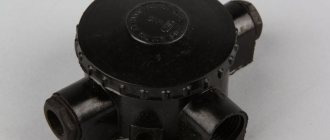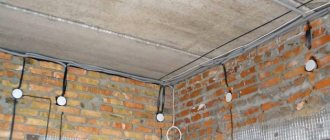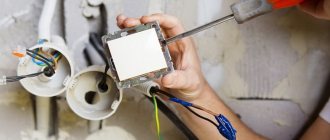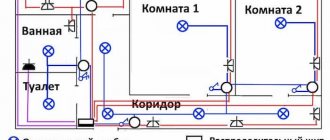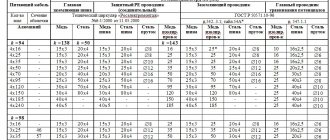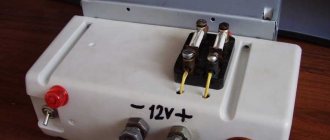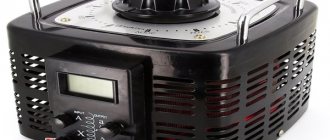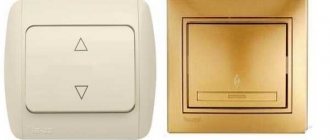The main difficulty that you may encounter when laying electrical wiring in a private house, apartment or specific room is the need to switch them inside the junction box.
There are several common mistakes associated with this process, and if you want to avoid them, there are a number of important points to consider. Laying out the wires into grooves or cable channels is not difficult. The distribution box is another matter: when working with it, you need to follow certain rules and recommendations.
Purpose of distribution boxes
Electrical wiring must be divided into groups depending on the energy consumer. For this purpose, similar structures are installed that perform important tasks:
- ensuring fire safety;
- aesthetics.
Under the body of the box there are conductors, which are thus protected from various damages. This allows you to increase the service life of electrical wiring.
Junction box with conductors
The main task of the distribution box
With this design, you can reduce the budget for organizing electrical wiring. After all, in the absence of a distribution box, a cable would have to be connected to each electrical appliance, which would create too many channels that would have to be hidden in the ceiling. In addition, all this does not look aesthetically pleasing.
At the same time, the correct distribution of conductors inside the box increases the level of fire safety in any type of room. This is due to the insulation of connections and flammable materials that are located in the wall. In addition, this design is convenient for repair work.
However, the main function of the distribution box is to distribute electricity between consumers that are installed in a specific room. In addition, the design of the product allows for expansion by adding additional branches (when it is necessary to install a new switch or socket).
You can add a branch to the distribution box for a new energy consumer
Open type installation
This method will be simpler and less time consuming.
Open installation type
Below is the step-by-step work to install the junction box:
- First, you need to completely turn off the power to the entire room and check the sockets with a multimeter.
- The points for attaching the box must be marked in advance.
- The box is connected to the wall using brackets. Usually the box already has holes for mounting.
- To connect all cables, you need to cut off the ends of the seals. The cuts should be thin so that dust does not get inside over time.
- Fasten the wires to each other. To do this correctly, you need to adhere to the color shades of the wires.
- After fastening the wires, you need to close the shield.
Important! Installation is quite simple and does not require calling a specialist to your home. A person with basic electrical knowledge can handle the job. But beginners are strictly forbidden to figure out the wiring on their own. This is fraught with short circuits and fires. In addition, improper installation can damage all household appliances in the room.
It is recommended to use electrical metal junction boxes in any room. It's cheaper than plugging every wire into an outlet, and it's also much safer. You should not install it yourself without special indicator screwdrivers and knowledge. Any interference with the wiring may result in a short circuit.
Why does the box have different names?
This piece of electrical equipment goes by several names, including: distribution box, branch box, junction box. Only their operating principle is the same: the box is a center where electricity is supplied from the power source, and then it is distributed through separate channels that go to switches, sockets and other devices. Therefore, such a design is usually called “distribution”. Otherwise, the box is also called a “branch”, this is due to the fact that only one cable goes into it, but several channels come out.
Note! The boxes are also called soldered boxes, which is due to the way the wires are connected inside. So, the wires must be soldered after twisting. We will talk more about this and other connection methods below.
Among some electricians, you can find another name for this box – “disconnection box”. This word is formed from two definitions: distribution and connection. After all, first you have to distribute the wires and then connect them to consumers.
Distribution boxes installed in the wall
Accordingly, if a store consultant calls the box differently, you shouldn’t be surprised, because it’s the same product. Rather, you should pay attention to the dimensions of the box, because you will have to make a recess in the ceiling for it. As a rule, standard products are produced in the form of a rectangle measuring 10x10x5 centimeters.
Prices for distribution boxes
Junction box
Will it be possible to do without junction boxes during the installation of electrical wiring?
Of course, it is possible to install wiring in an apartment without junction boxes, but this is impractical - then you have to pull many cables from the main panel to the power consumers, which is why deep grooves are made in the wall, which will have to be puttied. In addition, this involves spending money on the purchase of cables, so the only rational solution is to purchase distribution boxes for premises.
Corrugated pipes for electrical wiring
However, some users mistakenly believe that the connection point, which is located inside the box, is less secure than the whole cable. In fact, with proper installation, there are no problems with the junction box and wiring connections.
In addition, if you imagine that the box is missing and a malfunction has occurred, you will have to remove the wallpaper and chisel the wall to find the damage. If there is a design, it will be enough to remove the cover and inspect the condition of the electrical wiring.
Types of distribution boxes
You can find a large number of varieties of these designs on sale. Therefore, to choose one of them, you need to familiarize yourself with these types in more detail.
Designs have different appearances
Table No. 1. Types of junction boxes according to installation method
| View | Description |
| Open | Such boxes are not mounted into the wall, but fixed on the surface, which looks less aesthetically pleasing. Therefore, they are most often used in industrial-type premises to provide quick access to electrical wiring. In addition, similar products can be found in private houses made of timber. |
| Hidden | This type of junction box is most often used for residential premises. The structure is mounted in a pre-prepared hole. Some types require decorative covers, so they are not covered with a layer of plaster. This also allows you to have constant access to connections. |
Table No. 2. Materials for making the case
| View, illustration | Description |
| In this case, several materials of artificial origin are used to make boxes: polypropylene, polyamide, fluoroplastic. Such designs are popular among users regardless of the type of structure. They have many advantages: · high-quality insulation; · resistance to mechanical damage; · resistance to chemicals and fire. |
| Such boxes are used extremely rarely in domestic conditions, only if it is necessary to distribute wiring in a storage room or garage. Most often they are used in public places, in production, and are installed in an open way. These boxes are made from various aluminum alloys. |
Table No. 3. Types of distribution box configurations
| Type | Description |
| Without internal filling | Such designs are a type of body and cover. As many electricians note, this option is suitable for installing electrical wiring yourself. Products without filling have the following advantages: · you can make the connection of wires in the box in a convenient way; · If installed correctly, the contacts will not become loose. |
| With additional terminals | This type simplifies the installation process because it involves quick connection of wires with clamps. The disadvantage is that such boxes are not installed in rooms with high humidity levels, because the terminals begin to oxidize over time. |
"Empty" junction box
Products also differ in the number of inputs. At a minimum, the design is designed for two inputs (to connect two cables), and a maximum of sixteen inputs. It is necessary to choose one type or another based on the electrical wiring diagram of the room.
The designs also differ from each other in the degree of protection, so this criterion should also be paid attention to when choosing a box. This is important when installation needs to be done in a room with high humidity or high air temperature.
What do junction boxes protect against:
- The standard product assumes the presence of sealing rubber. As a rule, this is enough for most areas of the apartment.
- From dust particles. This is relevant at production facilities.
- From the water. Such boxes are installed in the bathroom, toilet, room with a swimming pool.
- From mechanical shocks. This is true if the box is installed outdoors.
- From exposure to high temperatures. Such products are purchased if there is a log house or if the walls are decorated with flammable materials.
In shape, the boxes are square, round and rectangular - the latter are used when there are many cables. Round designs are used when there is a small number of cables. In addition, they are often chosen for concrete floors.
Kinds
Boxes for connecting electrical wires come in different types and are classified according to many parameters.
By installation method
First of all, they are divided depending on the installation method:
- A distribution box for open electrical wiring (otherwise known as “outdoor installation”) is mounted on wall surfaces. To install it, no preliminary preparation of the base is required. It is attached directly to the wall surface using various fasteners.
- The distribution box for hidden wiring (it is called “internal installation”) is mounted in a special recess in the wall, which is drilled during installation work. These junction boxes, in turn, differ depending on the material of the wall in which they will be mounted. If it is in a concrete or brick wall, then you need to use a special crown to make a recess to fit the dimensions of the box. Simply cut a corresponding hole in drywall or other sheet materials.
By material
Boxes vary depending on the material from which they are made. First of all, these must be materials that would provide the connected wires with maximum protection for the entire service life. In this regard, electrical wiring boxes are made of high quality plastic and metals, which are also coated with a protective layer of anti-corrosion paint or primer.
For the manufacture of metal boxes, tinned steel sheets or aluminum alloys, which are not subject to corrosion, are used. If a fire occurs, the metal case will serve as protection for the contents of the box for some time, during which time it will at least be possible to de-energize the electrical network. Metal boxes are most often used in general purpose buildings (garages, utility rooms, sheds).
A plastic junction box will protect electrical connections no less effectively. For their manufacture, polyamide, polypropylene or cast fluoroplastic are used; these materials are not subject to decomposition by active substances. These plastic boxes provide excellent insulation against electric shock. In addition to good insulating properties, they also have sufficient mechanical strength. A plastic junction box is resistant to aggressive chemical liquids and can be kept in a humid environment much longer than a metal one. If there is a danger of open fire, then plastic does not burn, but melts; in this, of course, it is inferior to metal.
By other parameters
Distribution boxes vary in size and the following criteria play a major role here:
- their purpose;
- number of inputs;
- protection class.
At a minimum, the box can have two inputs, that is, two wires will be connected in it. The maximum number of inputs in one distribution box is 16. Accordingly, the more inputs, the larger the box in size and depth.
Boxes vary in shape and can be round, square or rectangular. For outdoor installation, it makes no difference at all what shape you use the box. But for indoor installation it is better to take a round one, because if you have a concrete wall, then making a hole in it is much easier than drilling a square niche.
All of the above criteria add up to the price of the junction box. The price is also affected by the degree of protection of this element:
- IP 20, IP 30 – for use only in dry rooms, there is no protection from humidity;
- IP 44 - for use outdoors and in rooms with high levels of humidity; when installing outdoors, you must choose a place under a canopy or canopy, and also avoid direct exposure to dust and water jets;
- IP 55 - for use in places exposed to precipitation, that is, boxes with this degree of protection can be installed outdoors in any conditions, they are completely protected from dust and water jets;
- IP 67 – for use outdoors in any weather conditions, as well as on the ground and in the ground;
- IP 68 - boxes with this degree of protection can be used immersed in water; as a rule, the immersion depth is additionally indicated for each product on the packaging or case.
For household electrical networks, boxes with a degree of protection of IP 55 are most often used.
Where is the distribution box installed?
Most often, they prefer to install the junction box under the ceiling at a distance of approximately 25 centimeters from it. This is associated with the safety of using electrical wiring, because the possibility of the protective cover falling off cannot be ruled out, which will cause electric shock to a person.
Junction boxes are fixed at height
Note! Another reason for accurately calculating the location of the box is the cable consumption for network wiring. Therefore, the closer you can bring the conductor to the consumer, the shorter the branch from the box to this point will be.
Prices for popular models of wall chasers
Wall chaser
Installation of a distribution box in a residential area
In this case, you will need to prepare the following devices and materials:
- A jigsaw with a special disk for creating grooves where the wires will be placed.
- A hammer drill is needed when you plan to “sink” the box into the wall, so you will need to prepare a hole.
- Hammer for additional cutting of openings after using a core drill.
- Wire cutters - for cutting wires to the required length.
- Wiring stripping tool.
- Additional devices for connecting cores.
- Tester.
Electricity supply diagram
Approximate power supply diagram for an apartment
In the diagram you can see where the distributors are installed. So, if there are few sockets and switches in the room, then here you can determine where to install additional channels.
Installation of a distribution box: step-by-step instructions
Step 1. First you need to display on the wall the lines where the grooves will go, according to the diagram.
Grilling is performed along these lines
Step 2. Next, in the designated places you need to make recesses for installing the boxes.
It is necessary to secure the box to the wall with self-tapping screws or plaster
Step 3 . Wiring is inserted into the box and connected to each other.
After connecting, check that the wiring is working properly
Step 4. Now all that remains is to close the box with the lid.
Putty is not applied to the decorative cover
Note! They try to secure the cover in such a way that when removing it the surface of the wall is not damaged.
Video - Installation of distribution box
Installation
To install the box in the wall, you first need to prepare a hole. You will need a special tool, preferably a hammer drill with a special attachment called a crown. What is she? A ring with a pobedite or diamond cutting edge. In the center there is a drill designed for concrete; it centers the crown, and it then cuts out a round segment from the wall. Drilling is done to the required depth, then the cut segment is removed from the wall using a chisel and hammer (you can use a special spatula that is installed on a hammer drill). In a similar way, a deep niche is made for each installed element of the electrical network (sockets, switches).
Then from the hole it is necessary to punch grooves in which the wires or cables are laid. Their ends must be inserted into the box (it has several special holes for this) and left protruding 10-15 cm for installation of the connection.
Then the boxes are smeared into the niche using a solution of alabaster or building plaster. All that remains is to make all the necessary wiring connections and close the installed element with a lid. The wires are connected by welding, twisting and subsequent soldering, crimping with sleeves or terminal blocks.
Now you know almost everything about junction boxes. Always start your electrical repairs with them. Purchasing these electrical network elements is not a problem now; the main thing is to decide exactly which ones you need?
Methods for connecting wires in a junction box
There are several basic ways to connect the wiring in a junction box. In order to choose one of them, you need to consider the options in more detail.
Stranding and insulation
This is an old, but proven method of connecting wiring over the years. The bottom line is that the ends of the conductors are first stripped of the insulation layer and then twisted together with pliers. After which this place is wrapped with electrical tape.
Twisting conductor strands
This method has advantages:
- ease of installation;
- no need for additional expenses.
However, there are some disadvantages:
- poor-quality connection of cores;
- inability to connect copper and aluminum wires.
It is worth noting that conductors are often connected in this way during temporary installation of electrical wiring. According to safety regulations, the connection method is not suitable for rooms with high humidity levels.
Soldering or welding
It is in these ways that you can make a durable connection of wiring cores. First, their ends are carefully stripped of the insulating layer, then twisted, but without effort. Next, you will need to solder the wires using solder and a soldering iron so that they turn out monolithic. Then you need to wait until they cool naturally, and only then wrap them with electrical tape.
Soldering wire cores
In cases of soldering thick wires, you will need to use a soldering iron with a dense copper tip.
Note! Some would-be craftsmen do not want to wait for the veins to cool naturally, so they cool them under running water. However, this should not be done - microcracks will appear on the surface.
The advantage of soldering is the reliability of the connections, but this method also has some disadvantages:
- the need to purchase a soldering iron;
- this is a labor-intensive process that not every beginner can handle;
- the connection is permanent;
- Over time, the level of resistance in the soldering increases, which leads to voltage leakage.
Often, instead of soldering, the cores are connected by welding. The process has a similar principle, only here a welding machine is already used, so the master must have the appropriate skills.
Video - Soldering twists
Crimping with sleeves
This is also one of the most reliable methods of fixing conductor cores. Here they are placed in a special sleeve and clamped with a crimping tool on both sides. After which this sleeve is wrapped with electrical tape or a cambric is attached to it.
Crimping of conductor cores
It is worth noting that the cores are placed in the sleeve either from different sides or from one. In the case of the first option, they will be connected in the central part of the tube. When choosing the second option, it is necessary to take into account that the diameter of the cores should not exceed the volume of the sleeve.
The advantages of such a connection should be noted:
- reliability;
- affordable cost of sleeves.
Disadvantages of the method:
- The sleeve is used only once. This means that in case of repair, it is torn down and a new one is fixed.
- You will need to use a special tool for high-quality crimping on all sides.
- Wires made of aluminum and copper are crimped only with special tubes, which are difficult to find in stores.
- Electrical installation will take time.
Terminal connection
If the wiring is made of different materials, it is recommended to use special clamps with springs or screws. Connecting the conductors using this method is not difficult; all you need is a screwdriver. The main thing is not to overtighten the bolts.
Connecting wires with clamps
Junction box materials
To install electrical wiring, it is necessary to select a junction box that would be well suited for installation in the location specified for the homeowner. Its characteristics must comply with the requirements and technical conditions.
Most often, the following requirements are imposed on distribution boxes:
- material of manufacture;
- overall dimensions and internal dimensions.
Below we describe in detail what materials distribution boxes are most often made from.
Metal
When laying electrical wires in warehouses, workshops and other premises that require not only good fixation of the wires, but also protection from negative production factors, there is a need to install distribution boxes with improved operational properties. In this case, metal becomes the optimal solution for choosing the box material.
Metal box
Metal products are most often produced by stamping from a sheet of steel with further priming and painting. The cover is secured using a screw connection. The structure of the box body is made airtight using sealing rubber gaskets at the electrical cable entry points and rubber gaskets for the lid.
Note! The disadvantage of such a box is that it costs more than plastic, and can also corrode over time.
You may be interested in Description of PRKA wire
The plastic model is cheaper
Plastic
Most often, various types of plastic are used to produce products of this type, such as junction boxes. Plastic has its advantages in the manufacture of boxes:
- does not conduct electric current;
- low cost;
- simplicity of technological solution for manufacturing different shapes and sizes;
- simple possibility of completing boxes with auxiliary elements from rubber gaskets, mounting strips, easy installation of fastening screws;
- The long service life of the product is due to the properties of plastic (resistance to natural destruction).
For your information! The downside is the material itself - if installed incorrectly, the box may crack. But experienced craftsmen always recommend giving preference to plastic. It is easier to change if necessary.
Wiring diagrams
It is necessary to become more familiar with the features of connecting the wiring from the junction box to consumers.
Prices for various types of voltage indicators
Voltage indicator
Connecting sockets
Often sockets are connected in groups on one line. So, 3 cables with several conductors are placed inside the box. Brown indicates the phase conductor, blue indicates neutral, and green or yellow indicates ground. Of course, some manufacturers use other colors.
Connecting sockets
The wires are laid out on a flat surface, and then cut to a certain length, but with a margin (so that it can be separated again). Next, it remains to fix them according to the diagram.
Connecting a switch with one button
This is where installation becomes more complicated. After all, there are three groups of electrical wiring with different connections. One conductor is responsible for supplying voltage from another box or panel, the second comes from the lighting fixture, and the third from the switch.
The phase conductor is fed to a switch, which is connected to the lamp. Here you should make sure that the voltage supply occurs precisely when the switch is closed. The neutral and grounding conductors from the lamp are connected to the shield.
The principle of connecting a switch with one button
Connecting a switch with two buttons
A three-core cable is connected to this type of switch (without a grounding conductor, because it is connected directly to the panel). The first conductor goes to the common contact of the switch, the second to the first button, and the third to the second button.
Note! The phase conductor is connected to the common contact, the zero is fixed directly from the board and lamps. The phase wires from the lighting fixtures are fixed with the cores on the buttons.
Connecting a switch with two buttons
